Spatial Distribution Analysis of Community Radio Stations as Means for Promoting Climate Change Adaptation Measures in Agriculture under COVID-19 Scenario, Southern Province, Zambia
Abstract
1. Introduction
2. Materials and Methods
2.1. Conceptual Framework
2.2. Methodological Framework
2.3. Study Area and Sample Size
2.4. Study Instruments, Data Collection and Analysis
3. Results
3.1. CRS Geospatial Mapping
3.2. Allocated Time to Climate Adaptation Measures Programs on CRS
3.3. Challenges and Opportunities for CRS in Promoting Climate Adaptation Measures
4. Discussion
5. Conclusions
Author Contributions
Funding
Institutional Review Board Statement
Informed Consent Statement
Acknowledgments
Conflicts of Interest
References
- Jain, S. An Empirical Economic Assessment of Impacts of Climate Change on Agriculture in Zambia; Policy Research Working Paper, No. 4291; World Bank: Washington, DC, USA, 2007; Available online: http://hdl.handle.net/10986/7478 (accessed on 11 October 2022).
- Aregheore, E.M. Country Pasture/Forage Resource Profiles, Zambia; FAO: Rome, Italy, 2009; Available online: http://docplayer.net/44874777-Country-pasture-forage-resource-profiles-zambia-by-eroarome-martin-aregheore.html (accessed on 20 December 2021).
- Khan, N.A.; Shah, A.A.; Tariq, M.A.U.R.; Chowdhury, A.; Khanal, U. Impact of Farmers’ Climate Risk Perception and Socio-Economic Attributes on Their Choice of ICT-Based Agricultural Information Services: Empirical Evidence from Pakistan. Sustainability 2022, 14, 10196. [Google Scholar] [CrossRef]
- Laskar, K.A.; Bhattacharyya, B. Community radio stations’ production responses to COVID-19 pandemic in India. Media Asia 2021, 48, 243–257. [Google Scholar] [CrossRef]
- Prahmana, R.C.I.; Hartanto, D.; Kusumaningtyas, D.A.; Ali, R.M. Community radio-based blended learning model: A promising learning model in remote area during pandemic era. Heliyon 2021, 7, e07511. [Google Scholar] [CrossRef] [PubMed]
- Servaes, J.; Malikhao, P. Development communication approaches in an international perspective. Commun. Dev. Soc. Chang. 2008, 2, 158–179. [Google Scholar] [CrossRef]
- Rware, H.; Kansiime, M.K.; Mugambi, I.; Onyango, D.; Tambo, J.A.; Banda, C.M.; Phiri, N.A.; Chipabika, G.; Matimelo, M.; Chaaba, D.K.; et al. Is radio an effective method for delivering actionable information for responding to emerging pest threats? A case study of fall armyworm campaign in Zambia. CABI Agric Biosci. 2021, 2, 1–11. [Google Scholar] [CrossRef]
- Davis, K. Agricultural education and extension in a time of COVID. J. Agric. Educ. Ext. 2020, 26, 237–238. [Google Scholar] [CrossRef]
- Benin, B.; Yu, S. Complying with the Maputo Declaration Target; International Food Policy Research Institute (IFPRI): Washington, DC, USA, 2013. [Google Scholar] [CrossRef]
- ReSAKSS. Regional Strategic Analysis and Knowledge Support Systems. ReSAKSS. 2018. Available online: http://www.resakss.org (accessed on 8 August 2021).
- Sampson, S.; Mazur, J.; Israel, G.; Galindo, S.; Ward, C. Competing Roles and Expectations: Preliminary Data from an Agricultural Extension Survey on COVID-19 Impacts. J. Agromedicine 2020, 25, 396–401. [Google Scholar] [CrossRef]
- Joseph, F.A. How Africa Is Promoting Agricultural Innovations and Technologies amidst the COVID-19 Pandemic. Mol. Plant 2020, 13, 1345–1346. [Google Scholar] [CrossRef]
- Phillips, C.A.; Caldas, A.; Cleetus, R.; Dahl, K.A.; Declet-Barreto, J.; Licker, R.; Merner, L.D.; Ortiz-Partida, J.P.; Phelan, A.L.; Spanger-Siegfried, E.; et al. Compound climate risks in the COVID-19 pandemic. Nat. Clim. Chang. 2020, 10, 586–588. [Google Scholar] [CrossRef]
- Blum, M.L. Investment requirements in extension to achieve zero hunger and adapt to climate change. J. Agric. Sci. Technol. A 2014, 4, 552–562. [Google Scholar]
- Drechsel, P.; Zimmermann, U. Factors influencing the intensification of farming systems and soil-nutrient management in the rural-urban continuum of SW Ghana. J. Plant Nutr. Soil Sci. 2005, 168, 694–702. [Google Scholar] [CrossRef]
- Robert, M.; Thomas, A.; Bergez, J.-E. Processes of adaptation in farm decision-making models. A review. Agron. Sustain. Dev. 2016, 36, 64. [Google Scholar] [CrossRef]
- Ageyo, J.; Muchunku, I.G. Beyond the Right of Access: A Critique of the Legalist Approach to Dissemination of Climate Change Information in Kenya. Sustainability 2020, 12, 2530. [Google Scholar] [CrossRef]
- Kapinga, M.D.; Siyao, P.O.; Sife, A.S. Role of Community Broadcast Media in the Dissemination of Climate Change Information among Small-Holder Farmers in Isimani Division, Iringa Rural District. Uongozi J. Manag. Dev. Dyn. 2020, 30, 1–37. [Google Scholar]
- Somanje, A.N.; Mohan, G.; Saito, O. Evaluating farmers’ perception toward the effectiveness of agricultural extension services in Ghana and Zambia. Agric. Food Secur. 2021, 10, 53. [Google Scholar] [CrossRef] [PubMed]
- Somanje, A.N.; Crespo, O.; Zinyengere, N. Conservation Agriculture Among Farmers in Kalomo, Zambia. In Beyond Agricultural Impacts; Elsevier: Amsterdam, The Netherlands, 2017; pp. 77–99. [Google Scholar]
- WHO. WHO Coronavirus Disease (COVID-19) Dashboard|WHO Coronavirus Disease (COVID-19) Dashboard. 2022. Available online: https://covid19.who.int/ (accessed on 11 April 2022).
- ZICTA. 2018 National Survey on Access and Usage of ICTs by Households and Individuals. A Demand Side Assessment of Access and Usage of ICTs in Zambia; Zambia Information and Communications Technology Authority (ZICTA): Lusaka, Zambia, 2018; pp. 1–33. [Google Scholar]
- Somanje, A.N.; Mohan, G.; Lopes, J.; Mensah, A.; Gordon, C.; Zhou, X.; Moinuddin, M.; Saito, O.; Takeuchi, K. Challenges and Potential Solutions for Sustainable Urban-Rural Linkages in a Ghanaian Context. Sustainability 2020, 12, 507. [Google Scholar] [CrossRef]
- Wu, J.; Guo, S.; Huang, H.; Liu, W.; Xiang, Y. Information and Communications Technologies for Sustainable Development Goals: State-of-the-Art, Needs and Perspectives. IEEE Commun. Surv. Tutor. 2018, 20, 2389–2406. [Google Scholar] [CrossRef]
- Wu, J.; Guo, S.; Li, J.; Zeng, D. Big Data Meet Green Challenges: Big Data Toward Green Applications. IEEE Syst. J. 2016, 10, 888–900. [Google Scholar] [CrossRef]
- Birner, R.; Davis, K.; Pender, J.; Nkonya, E.; Anandajayasekeram, P.; Ekboir, J.; Mbabu, A.; Spielman, D.J.; Horna, D.; Benin, S.; et al. From Best Practice to Best Fit: A Framework for Designing and Analyzing Pluralistic Agricultural Advisory Services Worldwide. J. Agric. Educ. Ext. 2009, 15, 341–355. [Google Scholar] [CrossRef]
- Ragasa, C.; Ulimwengu, J.; Randriamamonjy, J.; Badibanga, T. Factors Affecting Performance of Agricultural Extension: Evidence from Democratic Republic of Congo. J. Agric. Educ. Ext. 2016, 22, 113–143. [Google Scholar] [CrossRef]
- Elias, A.; Nohmi, M.; Yasunobu, K.; Ishida, A. Farmers’ satisfaction with agricultural extension service and its influencing factors: A case study in north west Ethiopia. J. Agric. Sci. Technol. 2016, 18, 39–53. [Google Scholar]
- Ntshangase, N.L.; Muroyiwa, B.; Sibanda, M. Farmers’ Perceptions and Factors Influencing the Adoption of No-Till Conservation Agriculture by Small-Scale Farmers in Zashuke, KwaZulu-Natal Province. Sustainability 2018, 10, 555. [Google Scholar] [CrossRef]
- Rogers, E.M. Diffusion of Innovations, 5th ed.; Free Press: Washington, DC, USA, 2003. [Google Scholar]
- Adesina, A. Technology characteristics, farmers’ perceptions and adoption decisions: A Tobit model application in Sierra Leone. Agric. Econ. 1993, 9, 297–311. [Google Scholar] [CrossRef]
- Swanson, B.E.; Bentz, R.P.; Sofranko, A.J. Improving Agricultural Extension. A Reference Manual; FAO: Rome, Italy, 1997. [Google Scholar]
- Bekele, N.; Demissie, B. Analyzing and Modeling of Geo Spatial Effect on Radio Wave Propagation System Using Geospatial Technologies. J. Geogr. Inf. Syst. 2017, 9, 777–795. [Google Scholar] [CrossRef]
- De Smith, M.; Goodchild, M.; Longley, P. Geospatial Analysis: A Comprehensive Guide to Principles Techniques and Software Tools, 6th ed.; Troubador Publishing Ltd.: Harborough, UK, 2018. [Google Scholar]
- Abunga, M.; Emelia, G.; Samuel, D. Adoption of modern agricultural production technologies by farm households in Ghana: What factors influence their decisions? J. Biol. Agric. Healthc. 2012, 2, 1–14. [Google Scholar]
- Cohen, L.; Manion, L.; Morrison, K. Research Methods in Education, 6th ed.; Routledge: New York, NY, USA, 2007. [Google Scholar]
- Creswell, J.W. Research Design: Qualitative, Quantitative and Mixed Approaches, 3rd ed.; Sage: London, UK, 2009. [Google Scholar]
- Maoba, S. Farmers’ perception of agricultural extension service delivery in germiston region, Gauteng province, South Africa. South African J. Agric. Ext. 2016, 44, 1–26. [Google Scholar] [CrossRef]
- Zewdu, G.A.; Malek, M. Implications of Land Policies for Rural-urban Linkages and Rural Transformation in Ethiopia. ESSP II Work. Pap. 2010, 15, 1–14. [Google Scholar]
- Cox, A.J.; Sseguya, H. ICT supported extension services in conservation agriculture information access for small holder farmers in Laikipia County, Kenya. In Proceedings of the 2015 IEEE International Symposium on Technology and Society (ISTAS), Dublin, Ireland, 11–12 November 2015. [Google Scholar] [CrossRef]
- Owusu, G. The role of district capitals in regional development—Linking small towns, rural-urban linkages and decentralisation in Ghana. Int. Dev. Plan. Rev. 2005, 27, 59–89. [Google Scholar] [CrossRef]
- Westoby, R.; Clissold, R.; McNamara, K.E.; Ahmed, I.; Resurrección, B.P.; Fernando, N.; Huq, S. Locally led adaptation: Drivers for appropriate grassroots initiatives. Local Environ. 2021, 26, 313–319. [Google Scholar] [CrossRef]
- Shahzalal, M.; Hassan, A. Communicating Sustainability: Using Community Media to Influence Rural People’s Intention to Adopt Sustainable Behaviour. Sustainability 2019, 11, 812. [Google Scholar] [CrossRef]
- Nepoklonov, V.; Maximova, M.; Sukharev-Krylov, I. Monitoring of spatial data coordinate basis integrity using coordinate transformations. E3S Web Conf. 2021, 310, 03009. [Google Scholar] [CrossRef]
- Chandra, A.; Jain, S.; Qadeer, M.A. GPS locator: An application for location tracking and sharing using GPS for Java enabled handhelds. In Proceedings of the 2011 International Conference on Computational Intelligence and Communication Networks, Gwalior, India, 7–9 October 2011; pp. 406–410. [Google Scholar] [CrossRef]
- Windarni, V.A.; Sediyono, E.; Setiawan, A. Using GPS and Google maps for mapping digital land certificates. In Proceedings of the 2016 International Conference on Informatics and Computing (ICIC), Mataram, Indonesia, 28–29 October 2016; pp. 422–426. [Google Scholar] [CrossRef]
- Ministry of Health. Zambia (COVID-19) General Dashboard. 2022. Available online: https://rtc-planning.maps.arcgis.com/apps/dashboards/3b3a01c1d8444932ba075fb44b119b63 (accessed on 2 April 2022).
- Cihan, P. Forecasting fully vaccinated people against COVID-19 and examining future vaccination rate for herd immunity in the US, Asia, Europe, Africa, South America, and the World. Appl. Soft Comput. 2021, 111, 107708. [Google Scholar] [CrossRef] [PubMed]
- Yusha’u, M.J.; Servaes, J. Communication for Sustainable Development in the Age of COVID-19. In The Palgrave Handbook of International Communication and Sustainable Development; Palgrave Macmillan: Cham, Switzerland, 2021; pp. 3–30. [Google Scholar]
- Abdulai, A.-R.; Chireh, V.K.; Tchoukaleyska, R. Engaging Diverse Audiences: The Role of Community Radio in Rural Climate Change Knowledge Translation. J. Community Engagem. Scholarsh. 2021, 13, 8. Available online: https://digitalcommons.northgeorgia.edu/jces/vol13/iss3/8 (accessed on 2 April 2022). [CrossRef]
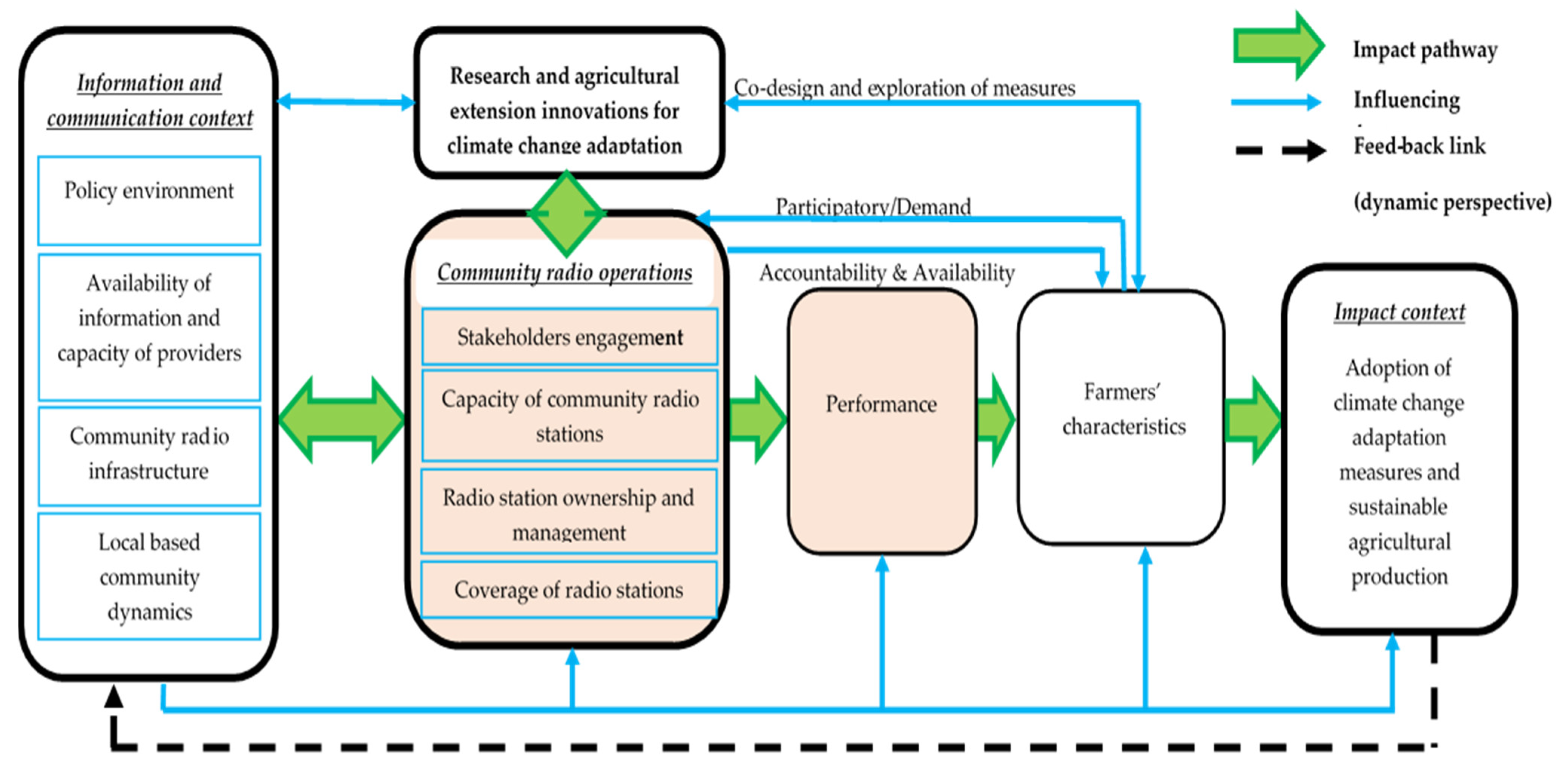
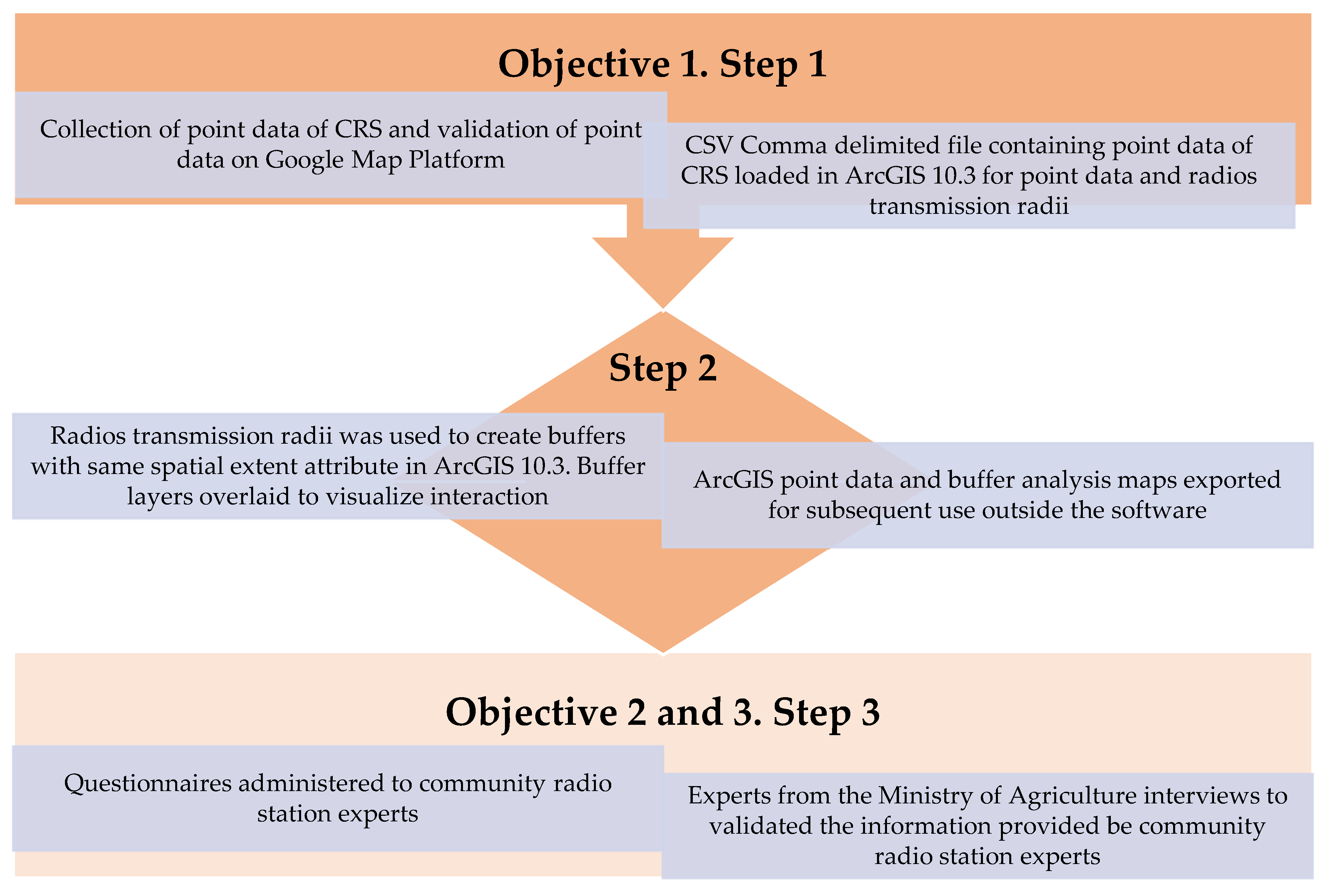
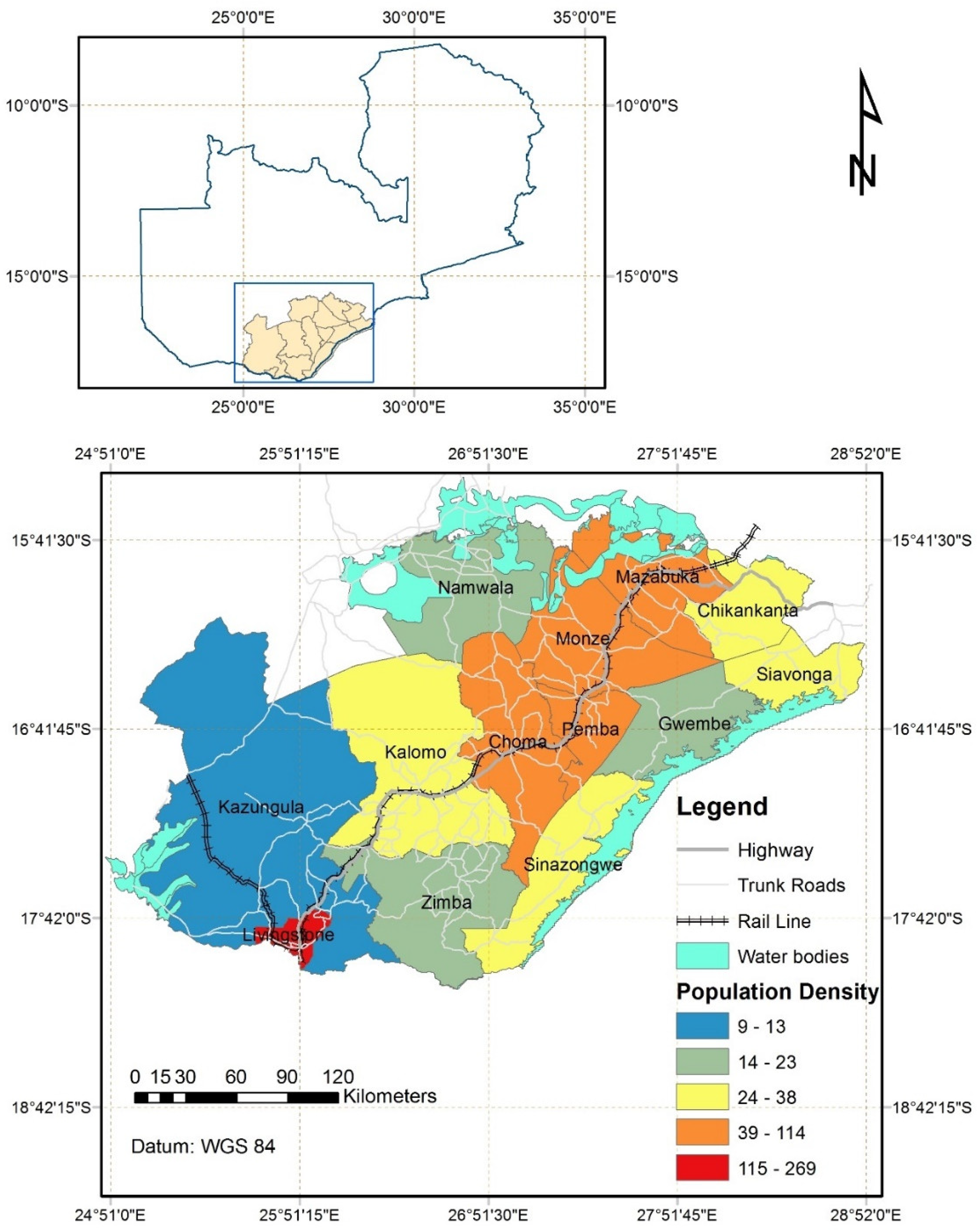
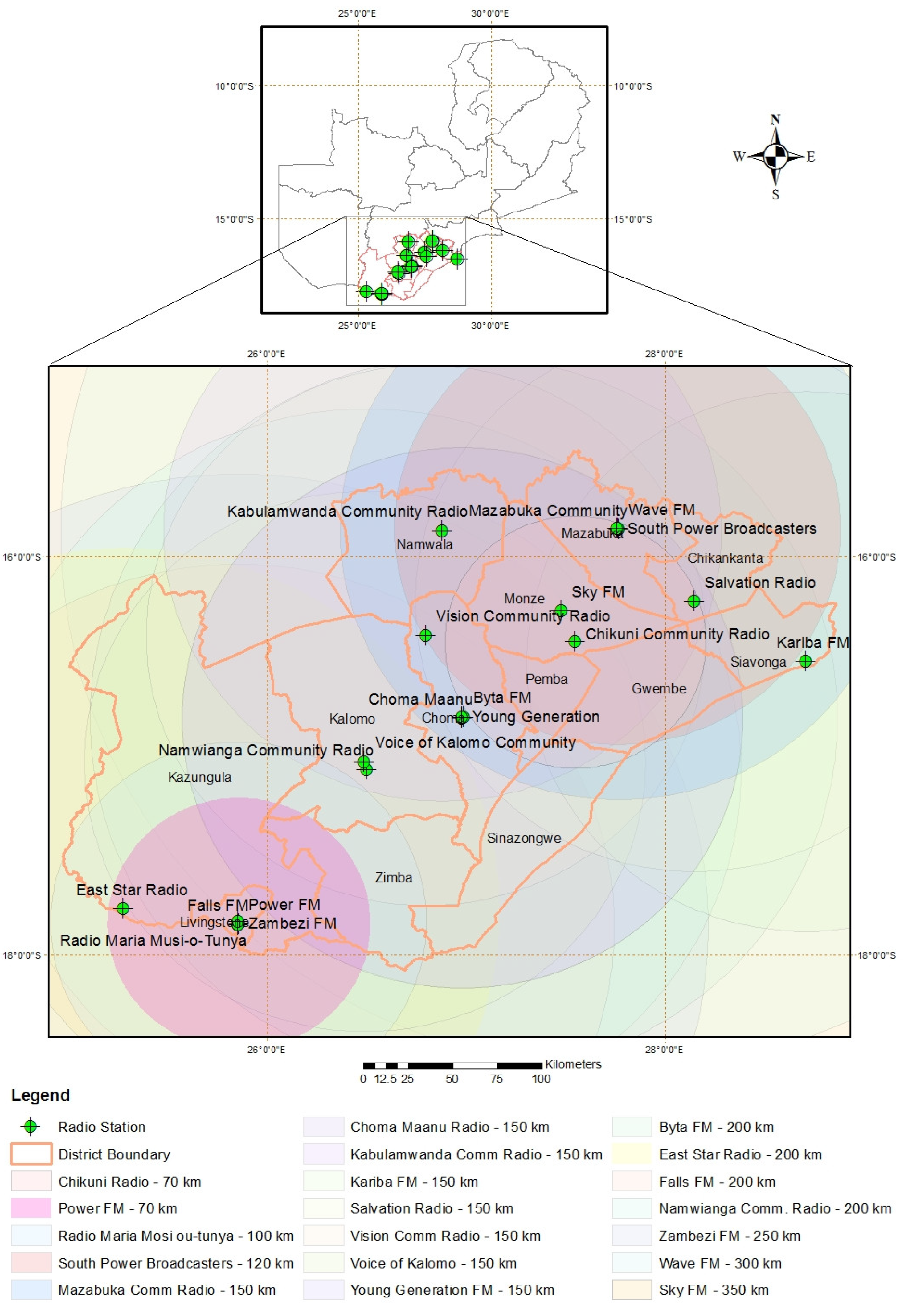
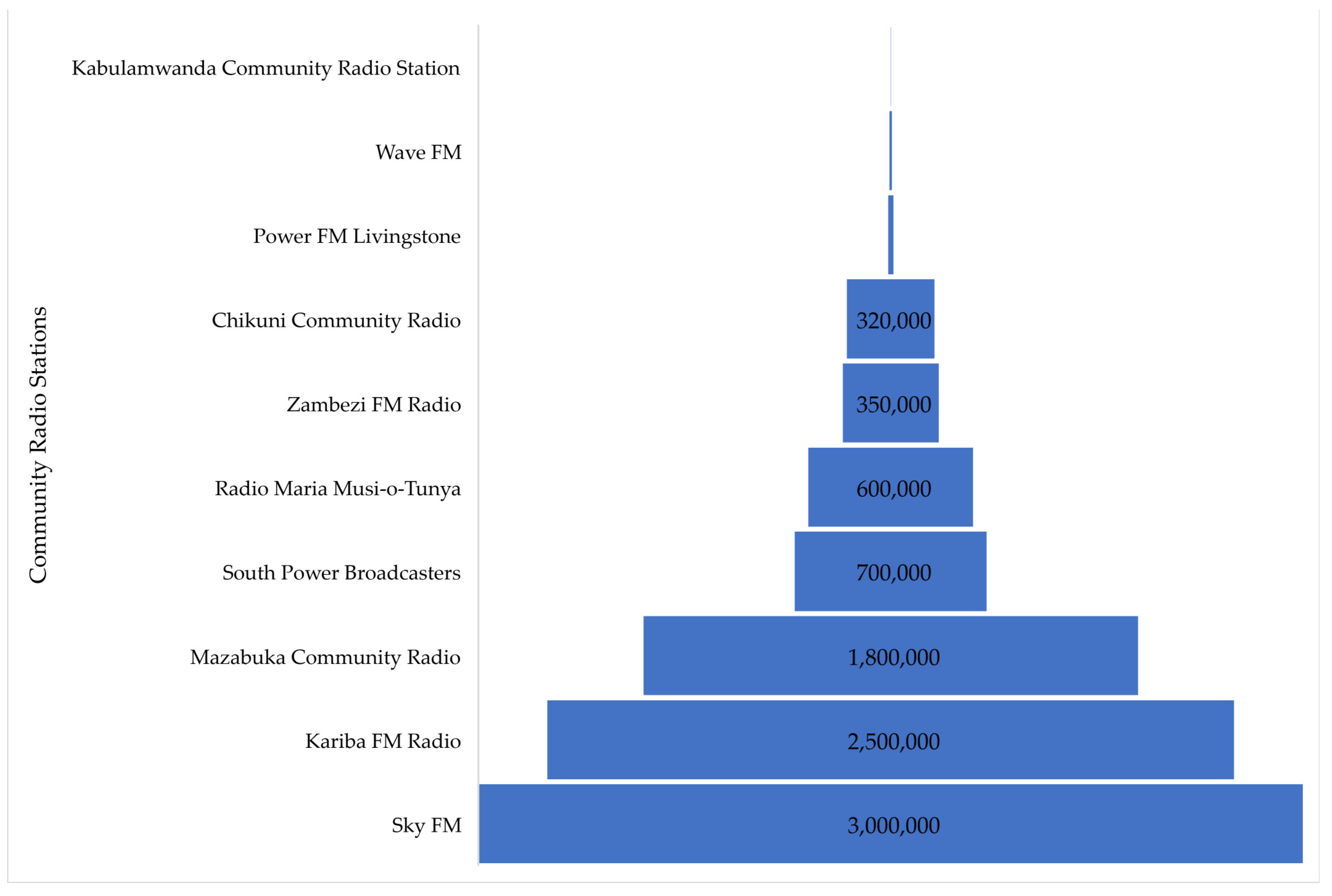
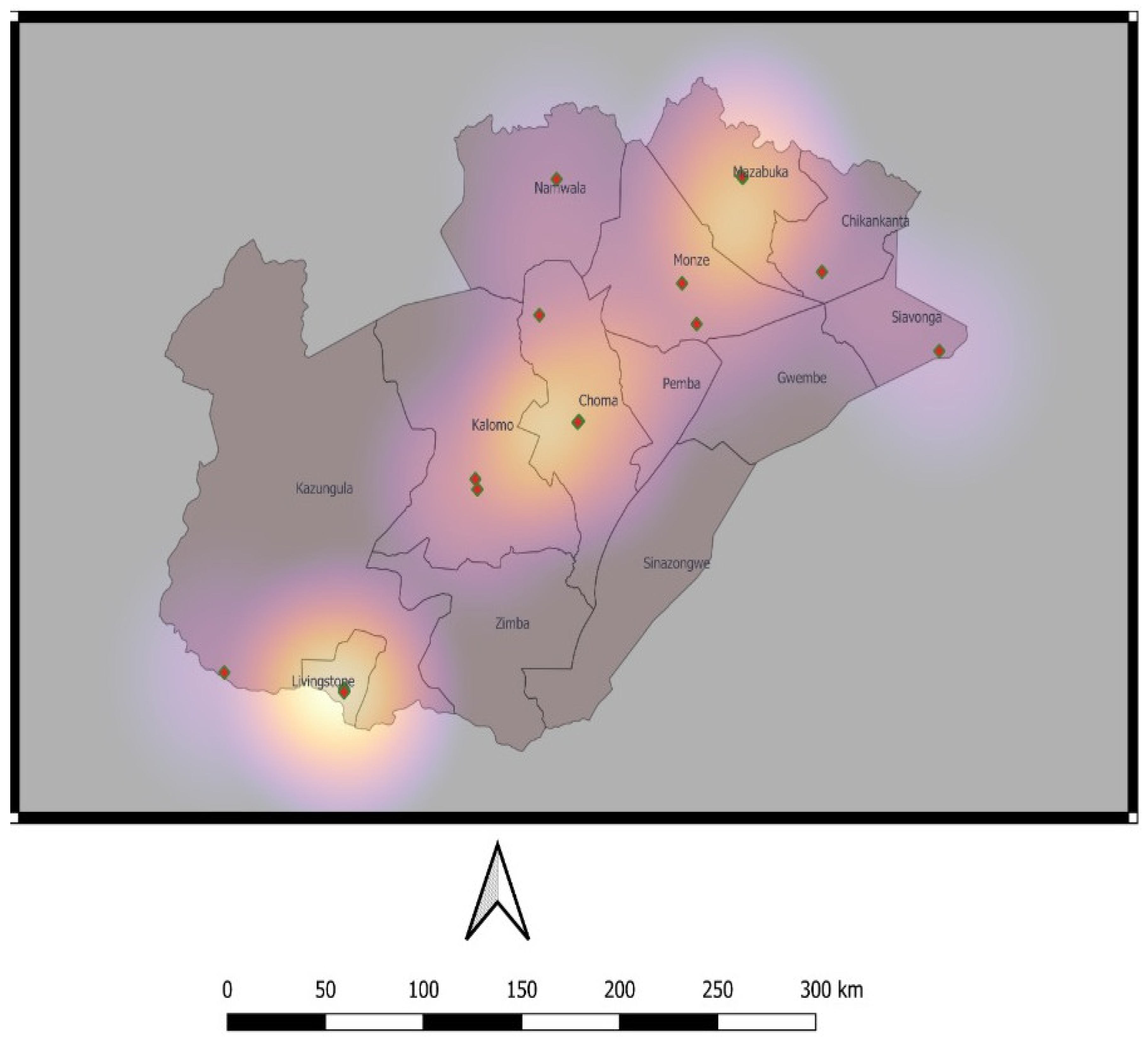
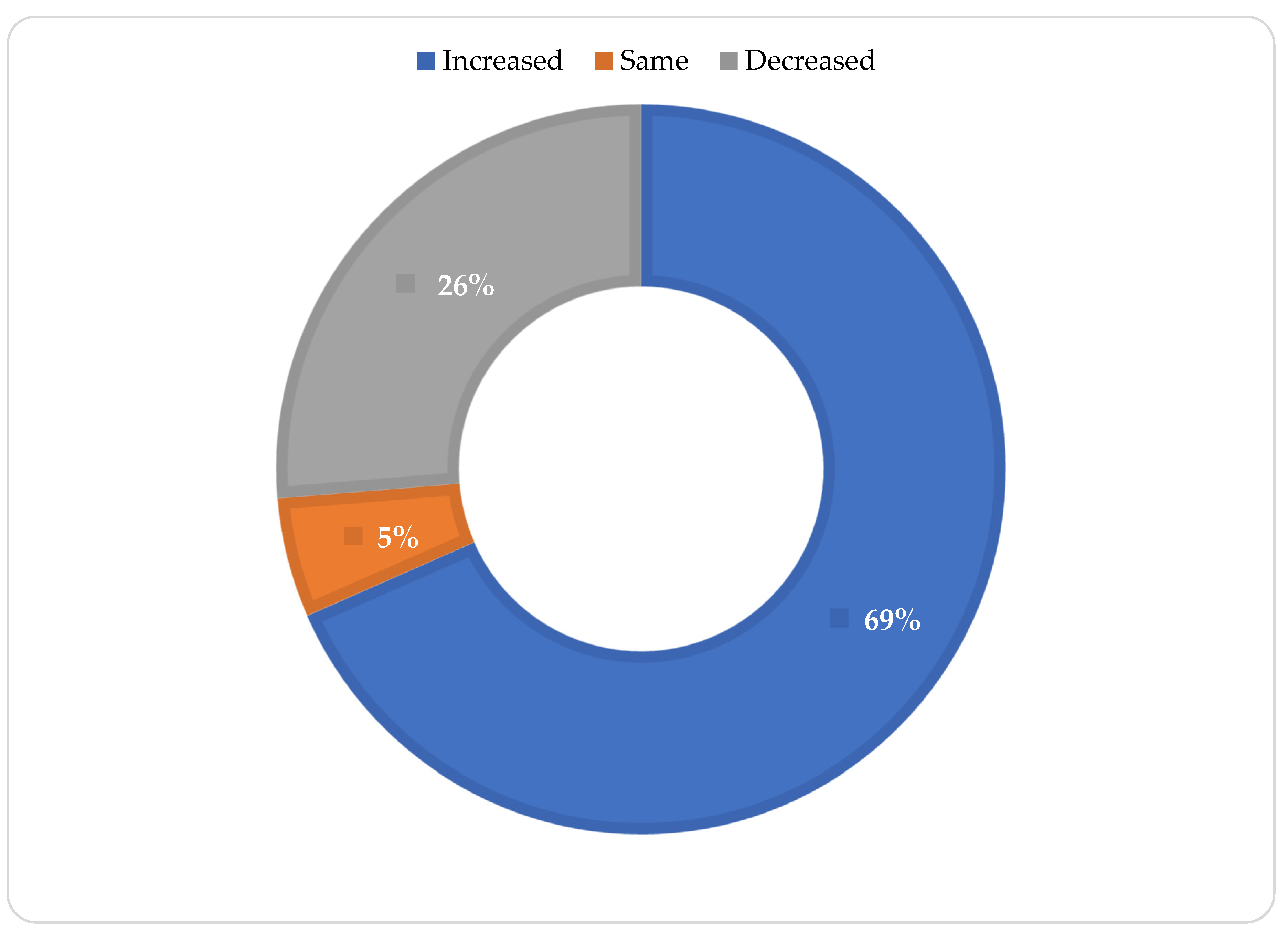

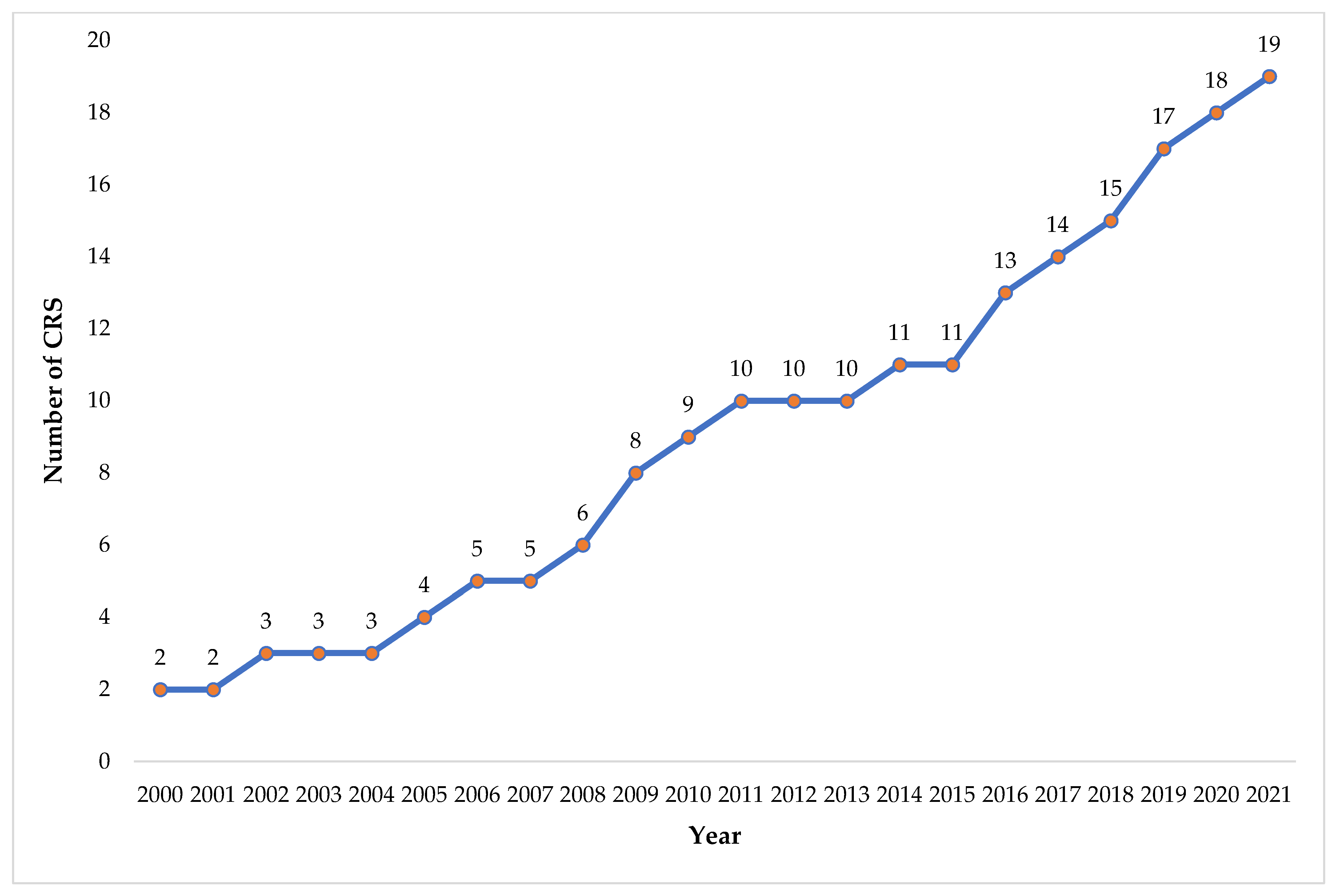
| Position | Frequency | Percent | Male | Female |
|---|---|---|---|---|
| Station Manager | 8 | 21 | 7 | 1 |
| Programs Manager | 7 | 18 | 5 | 2 |
| Marketing Manager | 3 | 8 | 2 | 1 |
| Reporter | 1 | 3 | 1 | 0 |
| District Agricultural Information Officer | 12 | 31 | 6 | 6 |
| Provincial Agricultural Information Officer | 1 | 3 | 1 | 0 |
| Senior Agricultural Officer | 5 | 13 | 5 | 0 |
| Agricultural Officer | 1 | 3 | 0 | 1 |
| Program Officer (Agricultural Research) | 1 | 3 | 1 | 0 |
| Total | 39 | 100.0 | 28 | 11 |
| Source: Survey |
| Time Allocation | N | Minimum | Maximum | Mean | Std. Deviation |
|---|---|---|---|---|---|
| Estimated time (%) allocated for agricultural programs | 19 | 1 | 60 | 16.65 | 18.830 |
| Estimated time (%) allocated for climate adaptation measures on agricultural | 19 | 0 | 100 | 47.32 | 33.771 |
| Source: Survey |
| Languages | Number of CRS | Percent | Percent of Cases |
|---|---|---|---|
| English | 19 | 33.9 | 100.0 |
| Tonga | 19 | 33.9 | 100.0 |
| Lozi | 13 | 23.2 | 68.4 |
| Illa | 1 | 1.8 | 5.3 |
| Goba | 1 | 1.8 | 5.3 |
| Bemba | 1 | 1.8 | 5.3 |
| Nyanja | 2 | 3.6 | 10.5 |
| Total | 100.0 | 294.7 | |
| Combination of Languages | Number of CRS | Percent | Valid Percent |
| Tonga and English | 3 | 15.8 | 15.8 |
| Tonga, Lozi and English | 13 | 68.4 | 68.4 |
| Tonga, Lozi Nyanja, Bemba and English | 1 | 5.3 | 5.3 |
| Tonga, Goba, Nyanja and English | 1 | 5.3 | 5.3 |
| Tonga, IIa and English | 1 | 5.3 | 5.3 |
| Total | 19 | 100.0 | 100.0 |
| Source: Survey |
Publisher’s Note: MDPI stays neutral with regard to jurisdictional claims in published maps and institutional affiliations. |
© 2022 by the authors. Licensee MDPI, Basel, Switzerland. This article is an open access article distributed under the terms and conditions of the Creative Commons Attribution (CC BY) license (https://creativecommons.org/licenses/by/4.0/).
Share and Cite
Somanje, A.N.; Mwansa, L.M.; Chisanga, K. Spatial Distribution Analysis of Community Radio Stations as Means for Promoting Climate Change Adaptation Measures in Agriculture under COVID-19 Scenario, Southern Province, Zambia. Sustainability 2022, 14, 15380. https://doi.org/10.3390/su142215380
Somanje AN, Mwansa LM, Chisanga K. Spatial Distribution Analysis of Community Radio Stations as Means for Promoting Climate Change Adaptation Measures in Agriculture under COVID-19 Scenario, Southern Province, Zambia. Sustainability. 2022; 14(22):15380. https://doi.org/10.3390/su142215380
Chicago/Turabian StyleSomanje, Albert Novas, Lauraine Mwila Mwansa, and Kafula Chisanga. 2022. "Spatial Distribution Analysis of Community Radio Stations as Means for Promoting Climate Change Adaptation Measures in Agriculture under COVID-19 Scenario, Southern Province, Zambia" Sustainability 14, no. 22: 15380. https://doi.org/10.3390/su142215380
APA StyleSomanje, A. N., Mwansa, L. M., & Chisanga, K. (2022). Spatial Distribution Analysis of Community Radio Stations as Means for Promoting Climate Change Adaptation Measures in Agriculture under COVID-19 Scenario, Southern Province, Zambia. Sustainability, 14(22), 15380. https://doi.org/10.3390/su142215380





